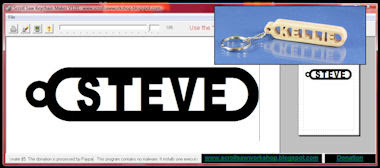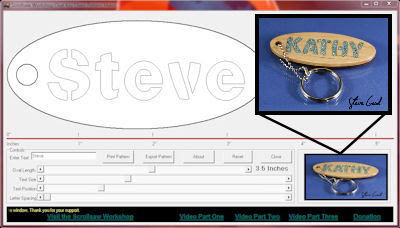The image below depicts a bevel cut side view. The smaller the angle the more the piece will extrude. The amount of relief depends on the thickness of the wood, size of the blade and the angle. In this project I used 1/2" thick wood, a #3 blade and a 1.8 degree angle. Your results will vary so make test cuts.
When you drill the interior holes it's best to use the smallest drill bit you have. I used a #57 micro drill bit and a #3 blade combination. This small hole is much easier to hide. It's also best to drill the entry hole at the same angle as the bevel.
_______________
Information: Micro Drill bits.
There are times when it is important to drill a very tiny entry hole. The project above is a good example. To hide the hole as much as possible I used a #57 micro drill bit. That is slightly over 1 mm. I chose this bit because I knew I could still get a #3 blade through the hole. The #57 is also large enough that it does not break as easily as the smaller micro bits. I have found that a #55, #56 and #57 will do most of what I need.
Another example where a very small drill bit is an advantage is interior veining of a pattern. If the vein does not start on the edge of a pattern you will have to drill a starter hole. Hiding a small hole is easier than hiding a large hole.
The last example is very small fret work. There are some patterns where the interior cut is too small for a standard size bit. Micro bits to the rescue.
These bits are too small to fit in a standard size chuck. You need an adapter chuck like the one I have above. Here is the Amazon link for this chuck. This chuck will fit in to your drill press chuck.
You can purchase the micro drill bits at this Amazon Link or you can buy them in small packs at this site. For scroll saw work I would not buy much smaller than a #55. Remember that a #71 bit is smaller than a #47. The numbering system is backwards from the actual size of the bit.
Using anything smaller than a #57 bit in a powered hand drill is very difficult. The bit will nearly always break. Even the larger micro bits will often break in a hand drill. You need a drill press or a pin vise. The pin vise is a hand held drill. They are effective on thinner wood but still difficult on anything thicker that 1/4". Here is a link to a pin vise.
your source for Pegas scroll saw blades and craft supplies.
_______________
Do you need a source for scroll saw ready boards?
Look no more because Heritage Wood Specialties is
the source you have been looking for.
Let me teach you to create a beautiful wooden portrait pattern. I will show you everything you need from start to finish. The video will show you the free software program you can download for Windows or Mac OS. I will show you how to install the program and configure it for best results.
Then I will show you the technique to take your photograph and make a pattern from it. When the pattern is complete we will go in the shop and cut it.
The DVD is $10 plus shipping. This is a data DVD that you will use on your computer to watch the video tutorial
Purchase the entire Scrollsaw Workshop pattern catalog for offline access.
This DVD has 1,964 patterns published from 2007 thru 2016.
The DVD is $20 plus shipping. Ships to 60 countries around the world.
The DVD is $20 plus shipping. Ships to 60 countries around the world.
You can view a video showing use of the DVD on a Windows PC and a MAC at this link
Click here to Order.
Click here to Order.
My two "Wooden Vases on the Scroll Saw" books make it easy.
The books are $12 each and available for instant download after purchase. Click for Video
Demonstration.
 Ad: Affiliate
Ad: Affiliate
WEN 4208 8-Inch 5 Speed Drill Press
- Includes a 1/2-inch keyed chuck and onboard key storage
- Operates at 5 different speeds: 740, 1100, 1530, 2100, 3140 RPM
- Spindle travels up to 2 inches with easy to read, locking linear depth stops for accurate and repeatable drilling operations
- Durable 1/3 HP induction motor develops ample torque and power
- 6-1/2 x 6-1/2" worktable is height adjustable and bevels up to 45 degrees left & right
- Swing: 8 inch. Motor: 120V, 60Hz. Horsepower: 1/3 HP.





































